 Green Iguanas – Some Myths about Green Iguanas
Green Iguanas – Some Myths about Green Iguanas
People who own green iguanas often have certain misconceptions about them. These myths could interfere with a person’s ability to take proper care of a green iguana. Some of these myths may not be too harmful. However, some of these myths could be dangerous to a green iguana’s health and well-being. Here are some common myths about green iguanas which you should know about:
1) You can feed lettuce to green iguanas – This myth has some truth to it. Of course, since green iguanas are best kept on a vegetarian diet, you can feed it lettuce. However, you should realize the fact that most types of salad lettuce have very little nutritional value. Some people realize this when it’s already too late to change the iguana’s diet. This is because a green iguana which is mainly fed lettuce will continue to eat lettuce even if better foods are added to its diet.
If you want to take proper care of your green iguana, you should feed it vegetables that have a high nutritional value. Examples include collards, turnip greens and mustard greens.
2) Iguanas will not outgrow their cages – Some people think that keeping iguanas in small cages will cause their growths to be stunted. These people provide small cages for their iguanas in order to keep it in a convenient size. This will definitely not help your green iguana. A green iguana, when properly taken care of, can grow up to six feet long. This means that keeping it in a small cage will only accomplish the feat of making your green iguana’s life very uncomfortable.
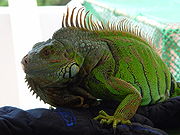
3) Iguanas need to consume gravel in order to help their digestion – this is a very dangerous myth. Some people add gravel or small pebbles to an iguana’s enclosure because they think that these help a green iguana to digest its food. However, you should realize that gravel or any such material could kill your green iguana if it is consumed. You should try to avoid feeding your green iguana these materials, whether by accident or on purpose.
4) Hot rocks are great for heating – some people add hot rocks to a green iguana enclosure, thinking that these rocks are good for an iguana’s body temperature. What you need to remember is that green iguanas are cold blooded. This means that if a green iguana sits on a hot rock, it can literally be cooked to death. If you wish to provide proper heating for a green iguana enclosure, you should use special lighting available in most pet stores.
5) Iguanas can eat insects, pet food, and other animal products – Many sources today still state that iguanas should be given animal protein as part of their diet. However, the truth is that green iguanas are best suited to an herbivorous diet. The body and metabolism of a green iguana is designed to utilize plant proteins effectively. Animal proteins, on the other hand, can prove to be very troubling to them. Consumption of animal proteins can cause your green iguana to develop gout. It can also lead to serious kidney problems. The only reason that iguanas eat insects in the wild is because these get mixed up with their food accidentally.
These are just some of the myths that you may have heard about green iguanas. By knowing the truth about these myths, you are now equipped to give the best care possible to a green iguana.
 Iguana Facts – Facts about Iguanas
Iguana Facts – Facts about Iguanas
Most iguanas can be seen in the tropical and subtropical forests, in the deserts and along seashores. Places like Canada, Galapagos Island, South and Central America, Caribbean Islands, Madagascar, Fiji in the South Pacific and off the east coast of Africa you will find the different kinds of Iguanas.
Iguanas are the most popular and the largest of the lizard family. Like the other common reptiles, they are also egg-laying and cold-blooded animal that has an ability to adapt to their environment.
Different species of Iguanas greatly differs on its behavior, color, size and their status as endangered in the wild. Common species like the red iguana and green iguana are still in great numbers but species like Fiji Island iguana and Brachylophus vitiensis are becoming endangered.
Different kinds of Iguanas are difficult to recognize as members of the same family. They act and look differently. Some iguanas have colors that are bright and vivid and others are dull. Each species of Iguanas has its own adaptation because it can be found in a variety of habitats.
Iguana as pets
In America, iguanas are kept as pets. Americans believe that by taking care of the iguana, they can save these iguanas from being extinct. Moreover, they are aware of the proper handling of iguanas, like the habitat, feeding habits and other things relevant to their existence.
Iguanas are typically herbivores, eating flower buds, young leaves and fruits. Some also eat the rare juicy mealworm, wax worm and cricket. In some places in America, iguanas are fed by different kinds or dark leafy greens and different fruits.
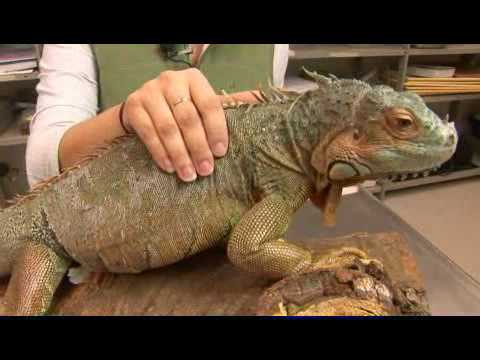
Species of iguanas grows quickly. They can be five times longer and a hundred times heavier as an adult than its size from hatchling, in just for twenty-four months.
That is why it is vital for your iguana to be given proper food and diet, living area and a proper range of temperature. Iguanas that are kept in a small place without any proper food and diet and no sun exposure would probably grow at a slower rate. The bones would also become weak and easily expose to metabolic bone disease and serious fracture.
How will you know if the Iguana is a male or a female?
Male Iguanas usually have large fat pockets on the back of head. They tend to have large or heavy jowls and have lager femoral pores or plugs on the underside of their thigh. Also males usually have larger blockier heads than females. On the other hand, female iguanas don’t have large fat pockets on their head. The latter also do not tend to have large or heavy jowls. They have very small femoral pores and plugs and usually have smaller heads.
Male iguanas are also involved in courtship behaviors of erecting it spines at the back and head bobbing. During courtship male iguanas are quite aggressive but usually they are quite timid and will flee if approached.
In addition, most female iguanas dig a burrow in a sunny area, lay eggs and cover them and it leave the eggs alone. The warm temperature makes the eggs incubate. Usually all eggs in the nest hatch at the same time. On the other side, iguanas face many dangers from loss of habitat to the prey on iguanas and humans eat them. Several measures can help iguana survive such as education programs for people living in iguana habitats, captive propagation in zoos and restriction on hunting.
 Iguana Enclosures – Building an Iguana Enclosure
Iguana Enclosures – Building an Iguana Enclosure
Iguanas prefer a different habitat where they can roam freely. They are more comfortable to stay in a tall, roomy, large and secure enclosure.
The iguana species being cold-blooded or endothermic need to heat their body to a high temperature daily. During the break of day, an iguana put itself into the sunlight to take some warmth in sun’s light. So, to be able to provide these needs you can build an enclosure for your iguana. You can do this by refitting or recycling an unused closet. It normally takes a longer time to refit closet properly but it will be helpful if you able to do it perfectly.
To be able to construct a perfect enclosure for iguana take a look at some possibilities for iguana enclosures:
Secured closets can be used for iguana enclosure. The size of the closet should be enough where iguana can linger. A closet with a depth of two feet is slightly narrow but it can be acceptable because of its height. For a young and female iguana, the length of the closet is all right. But for male iguana it would be confined unless it is a complement for an outdoor enclosure and a playing area in another place of the house. Daily interaction with iguana builds a bond of trust with its owner.
If your iguana lives in an open cage that is made of wires and they are under heated, the iguana may have difficulty getting the most favorable optimum level of temperature. Thus, they might feel weak.
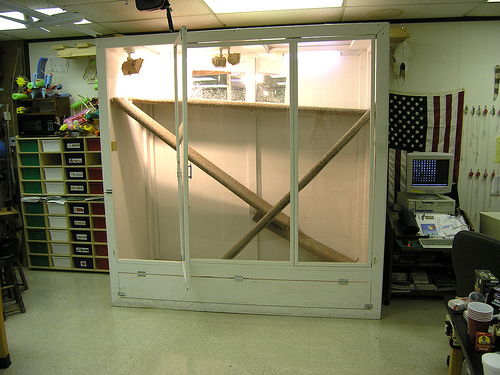
That’s why providing a closet would be a best option. A simple closet can also be the perfect place for your iguana to have a controlled environment and temperature. However, removing waste and transporting water can be the most difficult task of setting up closet for iguana, since it is rarely close in a sink or in a bathroom. Making the closet safe and clean is the real challenge in using closet enclosure.
Iguana should not have too much space for them to hide and escape the heat. Just make the bottom two feet for space storage. Some iguanas are jerky and tend to find a hiding place usually on the bottom area. And this might bring them to the risk of having hypothermia.
The enclosure must have a round closet bar and a top shelf. Closet bar could be used to hang up the lightning fixture but it will be too low for this. Instead of hanging it to the ceiling, you can move it up ‘til the top of the closet and clip lights to it. It’s your choice; however always remember that maximizing space is the top priority.
The closet door should also be considered in using closet enclosure. The closet door will help hold the heat but it would also prevent air circulation. You have a choice to put up a screen door in the closet door space. You can inset this screen door on one side and you still have solid door to pull lock for the cold nights. Also if you have a plexi glass or solid front, always give vent to air in the wall above the door.
These are just some possibilities in using closet enclosure. You can add whatever is needed to make your iguana comfortable. Just be creative and keep in mind that your pet would live longer if given a proper enclosure.
 Iguana Care – The Basics of Iguana Care
Iguana Care – The Basics of Iguana Care
There are a lot of people who seem to adore the iguanas and they end up buying the baby iguanas out of a spur of the moment decision. But then when these baby iguanas grow larger than what they have expected at first, they cram as to whom to give them to. If the iguanas are given the utmost care, they are likely to grow really large. It is vital to know that the iguanas can grow to some really large measurement, in fact, even larger than their containers. If you do intend to keep an iguana under your care, it is relatively essential to know the basics of iguana care.
The Selection of Iguana
If you intend to pick an iguana to be your pet, it is important to get the iguana that looks active and alert. But make sure that your choice will also get calmed especially when you try sticking your hand into its tank. The iguana of your choice must possess bright and clear eyes, must be free from any sort of abrasion, sores, scratches, and any from of marks, and should possess good health. Ensure also that the iguana that you are to buy is not in any way covered with feces that signify its dirty environment. A disgusting environment means the presence of bacteria and the possible outbreak of a disease that can harm the health of the iguana.
The Housing of the Iguana
For starters, the iguana can be kept in a tank that measures about 30 to 50 gallons. During its entire growth, it will be necessary to have a custom built cage for your pet. It is important that the cage should be higher since iguanas love to jump around. The cage bottom cover is also another important consideration to dwell on. The cover can be an orchid bark, indoor or outdoor carpeting, an artificial turf, a newspaper, or an alfalfa pellets. Remember that wood chips or barks are unadvisable, as they tend to attract insects and termites. Meanwhile, those cedar chips can be toxic too.
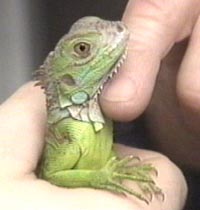
It is better that you set up some branches to allow the climbing sprees of the iguanas. Take note that they are tree-dwelling lizards. The branches must be able to hold on the size of your pet iguana. Hot rocks are likewise not recommended as a substitute for the lighting of the tank.
The Heating Technique
Iguanas should be maintained warm so that proper digestion of their food will be allowed. This technique will also save them from diseases. A good type of thermometer must be placed inside the tank so as to monitor the temperature of the house. There should be a basking spot that has a temperature of between 95-100 degrees F. One of the best heat sources that you can opt for is a spotlight. Other options include the undertank heaters, heat tape, or ceramic lights. Some recovering iguanas will need warmer temperatures especially at night.
The Feeding Scheme
It is important to be very careful with the food that you feed your iguanas. The green iguanas are plant-eaters. Any kind of animal protein should not be feed to them. They may like the pizza and junk food treats but these food will do them no good and will henceforth subject them to kidney failures. Vegetables must be given to them in minimal quantities. Spinach is a NO NO to them.
The diet required for iguanas are the food that contain high content of calcium, vitamin D3, and low in phosphorous. The commercial iguana food can also be made part of their diet.
 Iguana Cantina – Some Vital Considerations Posed on the Care for Iguana Cantina
Iguana Cantina – Some Vital Considerations Posed on the Care for Iguana Cantina
The iguanas are among the most well-known reptiles which are often purchased from the leading pet shops all over United States. The iguana can grow in almost any type of climate and could utterly measure between four to six feet in terms of its length and from ten to fifteen pounds in weight. When taken captive, the iguanas can live a span of twelve to fifteen years and sometimes up to twenty years provided that they are maintained to the fullest level. Since the iguana cantinas are originally from the humid and hot environments, it is rightful to assume that these reptiles are most active when the sun is up. At times when danger is imposed on them, they can be expected to use their defense mechanism tools such as their strong tails, nails, and jaws.
In their natural habitat, the iguana cantinas are spotted to be always hiding from their predators. They have very strong senses of sight, hearing, and smell and can easily detect the dangers abound. Most of today’s youngsters and teenagers buy iguanas out of severe impulse but then therefore disregarding the vital facts about their proper care. As a general knowledge for everyone, sufficient basics about the requirements for caring for an iguana must be taken into consideration.

The Iguana’s Indoor Housing Concerns
The young iguana cantina is able to live on an aquarium filled with thirty to fifty gallons of water. But of course as they are properly fed with the rightful diet, their growth would seem to advance in a matter of months. This means that the aquarium size should be adjusted as well. The aquarium enclosures come in a variety of styles and are either made out of plexiglass, wood, or simple glass. The substrate to be used must be something that can help you out easily. If you want to save, you can make use of newspapers. Among the other cool choices are the indoor and outdoor carpeting, linoleum, and artificial grass. Materials to avoid are soil, sand, and bark because they commonly invite insects and pests to thrive in them. This will in turn cause harm to your pets. The iguana habitat should be disinfected and cleaned two times in a week. It is also important to set up pieces of rocks, branches, broad limbs, or drift woods as climbing materials for the iguanas.
Water for their Habitat
Even the iguanas crave for water and this need of theirs should come handy. Most of their water intake source comes from the plants which they come to consume in their diets. When the iguanas are taken inside their tanks, they love to drink water from the woods or leaves inside the cage. Bathing the iguana is another good source of water intake into their bodies. This will further train the reptile to be accustomed with the water. When bathing your pet, lukewarm water must be used.
The Outdoor Sunlight for the Iguanas
Nothing can ever compare with the natural light coming from the sun. Sunlight will make your pet iguana cantina healthier. In a week, the iguana must be exposed to natural sunlight from five to ten hours. If you wish to place your iguana in a cage outside of your home, you should ensure that cats, dogs, or any other wild animals must not be present to pose danger on your pet.
 Iguana Habitats – Some Accessories You should Include in Iguana Habitats
Iguana Habitats – Some Accessories You should Include in Iguana Habitats
If you have met the basic light, heating, space and humidity requirements of an iguana habitat, you might think that your work is all done. However, it should be stated that those are just the basic parts of an iguana habitat. This means that although these factors alone will let your iguana survive, these may not necessarily allow your iguana to thrive.
In order to assure the best of health for your iguana, the iguana habitat should have these accessories:
1) Substrates – substrates compose the surface of the iguana habitat. In choosing a substrate for your iguana habitat, you should remember the fact that iguanas constantly flick their tongues. This habit allows your iguana to process different types of information about their environment. You should not use anything small like wood chips, sand, or gravel as a substrate because of this reason. Anything that sticks to the tongue of the iguana is likely to be eaten. San and gravel would be very dangerous to the iguana if they are ingested. This goes for any particulate materials.
In choosing a substrate, you might want to try newspapers with non-toxic ink. You could also try to use other types of paper, as long as they are not toxic to animals when ingested. Some people prefer to use pieces of indoor and outdoor carpeting as substrates for their iguana habitat.
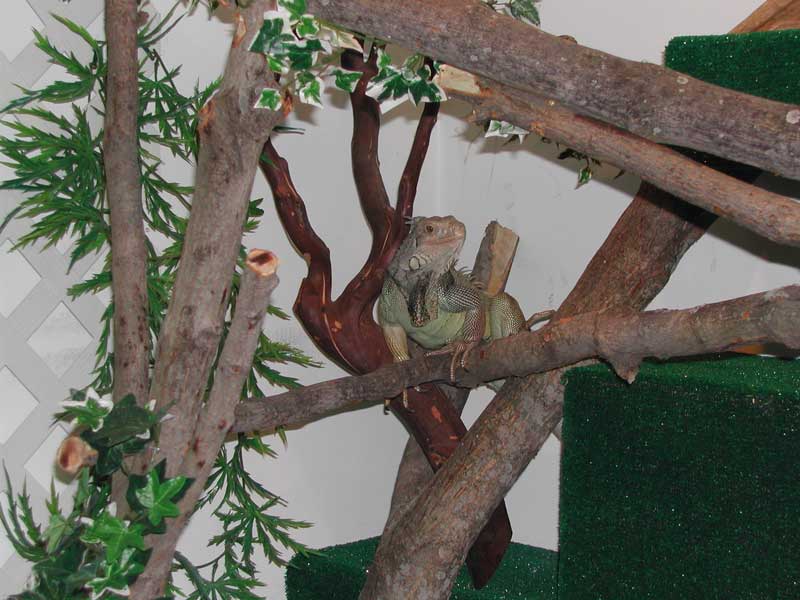
2) Basking and climbing accessories – Iguanas are arboreal. In the wild, iguanas spend most of their time up on trees. This means that you need to provide some sort of climbing material in your iguana habitat. Try including some shelves in an iguana habitat to simulate branches of trees.
If you include branches in your iguana habitat, you should provide some that are big enough for your iguana to lie on comfortably. You should also cover them with some sort of material that will help them in climbing. One option is to cover the branches with carpeting. The branches will also serve as basking places for your iguana. These spots are where your iguana will go to in order to relax.
3) Food and water dishes – you should provide your iguana with dishes for food and water. Although iguanas are not really inclined to drink often, it is still important that you provide them with a source of fresh water daily.
Iguanas love to soak in a water dish, so you should provide one that’s just the right size for your pet. It should be big enough so that the iguana won’t tip it over when getting in and it should be shallow enough so that the iguana won’t drown. You should also realize that after soaking, an iguana usually likes to poop in the water. This means that you will have the responsibility to change the water in the dish and sanitize it regularly.
4) Hiding places – there are times when an iguana likes to be alone and unobserved. This means that you have to provide a suitable hiding place in your iguana habitat. You could place a log, a rock, or anything which your iguana could hide behind. Just like people, iguanas need privacy too.
When you add these accessories to your iguana habitat, you can be sure that your iguana will be living in a very ideal enclosure. This means that your iguana’s health and well-being will be secured.
 Iguana Cages – The Essential Components of a Proper Iguana Cage
Iguana Cages – The Essential Components of a Proper Iguana Cage
When people think about buying an iguana, different questions come to mind. More often than not, one of these questions is: Where do I keep it? People then try to find out the components of an iguana cage. If you are trying to find the best iguana cage for your pet, here’s a guide for you:
1) Size – The first thing you want to know about is how big the iguana cage has to be. Some people have the misconception that the cage will limit the size of the iguana. This is not true. An iguana under ideal conditions will grow up to 6 feet long. This means that you will need to have a huge iguana cage in order to accommodate your pet. In fact, some people provide a whole room instead of an iguana cage for their pets!
Of course, if you are not yet ready to provide this space for your iguana, you could choose to delay until your iguana grows to its full size. However, the iguana cage that you provide should be large enough to contain the activities of your iguana. It should not cramp the animal in any way. If you choose to wait until your iguana has grown to full size, you should at least prepare and make plans for the time when you are going to need a bigger iguana cage.
2) Temperature – an iguana is cold blooded. This means that they need to regulate their body temperatures by making use of the environment. What are the implications of this? This means that you need to provide different temperatures in the iguana cage. This is so that the iguana can move from different spots to properly regulate its body temperature. You should also try to include a source of heat without light which will be used during the night time.
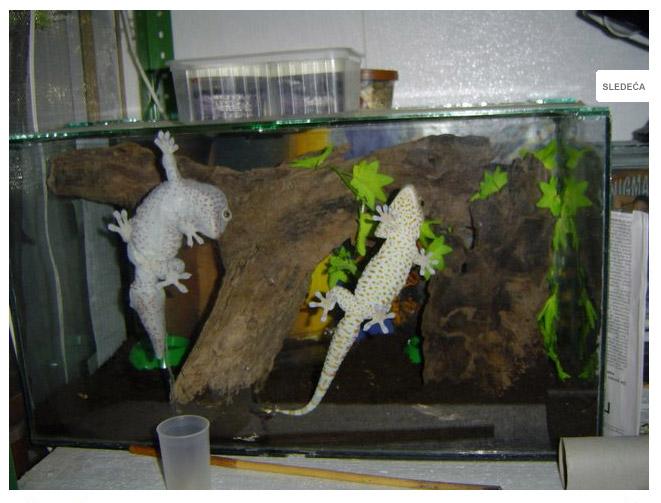
3) Humidity – iguanas require high levels of humidity to live comfortably. They are easily dehydrated because of the fact that iguanas aren’t really inclined to drink much. This is because the native habitats of iguanas have high humidity and this keeps them from being dehydrated. Dehydration can lead to kidney failure. This means that not having enough humidity can shorten the life of your iguana. Another reason to keep your iguana cage humid is the fact that humidity helps loosen skin. This means that an iguana will have an easier time shedding skin if it is kept in a humid environment. If you wan to keep your iguana healthy, you should provide an iguana cage that has a humidity of 65 to 75 percent of the air.
4) Lighting – iguanas need a source of UVA and UVB light. Of course, the best source that you can make use of is the sun. This does not mean that you should place your iguana cage in a sunlit area. The glass or plastic of iguana cages filter out the UV light much needed by iguanas for production of vitamin D3. This vitamin helps in calcium consumption. This means that you need to let your iguana bask in direct sunlight as much as possible. This helps in developing strong bones and preventing Metabolic Bone disease which is a very common cause of death among iguanas in captivity.
Other than the sun, your iguana cage should also include an artificial source of UVA and UVB light. This is in order to make up for days when the sunlight is not enough for your iguana.
 Iguana Foods – Some Issues about Iguana Food
Iguana Foods – Some Issues about Iguana Food
People who think that iguanas only need to be given lettuce as food would be very wrong in their assumptions. Feeding an iguana has a lot of issues involved and a good iguana owner should learn as much as possible about these issues. Here is a guide to help you with some of the issues surrounding iguana food:
1) Vegetables – ther5e are guides which still say that iguanas should be fed insects and they may eat cat and dog food. The fact remains, however, that iguanas have bodies that are designed for effective consumption of plant protein. That means that your iguana is better off as a vegetarian. Iguana food should consist of vegetables that have high nutritional value such as collards or mustard greens. Occasionally feeding it lettuce is okay but you should not regularly do this since most types of salad lettuce contain very little nutritional value.
Why is an iguana better off eating vegetables? Well, an iguana will have a hard time processing animal proteins. This task requires a lot of work from the kidneys. This means that an iguana which is fed animal protein has a high chance of developing kidney problems. Animal proteins are also hard to absorb. Often, unabsorbed animal proteins are stored in the iguana’s body as uric acid this may lead to gout.
So, now you know why iguana food should consist of as much veggies as possible.
2) Water – iguanas tend to drink water only sparingly. If you do not have enough humidity in the enclosure, this would mean that your iguana will spend most of its days at least partially dehydrated. This can be bad for your iguana.
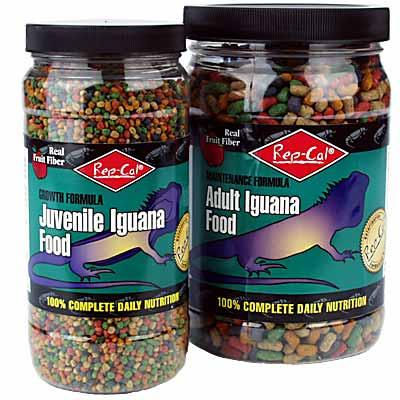
An owner should try to get an iguana to drink as much water as possible. Since iguanas are not naturally inclined to do this, you should take some steps to accomplish it. One way is to spray your iguana food with water. This way, the iguana will get the moisture it needs when it is feeding.
Another good idea is to try and train your iguana to drink as much water as possible. You can do this by placing a treat inside the iguana’s water dish. Do this regularly and soon, you will be able to train your iguana to drink from the bowl on its own.
3) Temperature – iguanas are cold blooded. This means that they depend on the heat of the environment for their bodily functions. No matter how good the iguana food you provide, the iguana will not be able to properly digest it without the proper temperature. After feeding, the temperature in the enclosure should be kept at least 85 degrees Fahrenheit. This will aid in the proper digestion of iguana food.
4) Calcium and phosphorus – When choosing iguana food, an owner should always keep in mind that iguanas need calcium and phosphorus in a 2:1 ratio. This means that you should try to choose foods that contain these nutrients.
5) Light – another issue about iguana food is the need for proper lighting. Iguanas need UVA and UVB rays to produce vitamin D3. This nutrient facilitates the proper absorption of calcium in the body. There are actually many types of artificial lighting that provide these rays, but the best source is still the sun. So if you want your pet to absorb the nutrients in the iguana food properly, make sure that you let it bask in direct sunlight as much as possible.
 Iguana Illnesses – Iguana Illnesses that need Immediate Attention
Iguana Illnesses – Iguana Illnesses that need Immediate Attention
Like humans, these iguanas actually also fall ill. If you have learned to love your pet iguanas, you might as well want to keep them for long. Here are some of the most common iguana illnesses that require immediate veterinary attention and proper medication or else you will lose your pets.
Fibrous Osteodystrophy or the metabolic bone disease. This iguana illness comes as a result of extreme malnutrition especially when they are not fed well. Most of the shops selling the iguanas give out worthy nutritional tips and advices to the buyers of these reptiles. Most of the pet owners prefer to feed their pets with squash and lettuce. In truth, the lettuce is a water sponge—meaning there is no nutrition to be derived from it. Such shortcoming is again aggravated by the insufficient vitamin D3 and calcium intake by the reptile. When they get exposed to this dangerous situation, they might in fact die. Among the vital symptoms of the disease are a swollen lower jaw, listlessness, rubbery or soft face and lower jaw, difficulty in eating, and swollen limbs. At most times, the spine and the limbs also easily get fractured.
The paralysis of the back legs. This is the result of a deficiency in vitamin B1. The tail also gets affected. With this comes the injection of the essential minerals and vitamins to the reptile and a change in its diet is as well recommended.
The nose abrasions. The frequent attempts of the reptile to escape cause the abrasions and scratches to its face and nose. When they are in search for a way to escape, they often rub their noses on the enclosures of their tanks. The abrasions are often caused by the wire, glass, or plastic enclosures of their cages. When the nose abrasions remain untreated, ulceration of the rostrum, bacterial infection, and other deformities could result.

The thermal injuries or burns. The burns are usually acquired through the contact with the heat sources within the tank enclosures. Among the typical culprits are the hot rocks and light bulbs which are left exposed. The lights are advised to be placed above the enclosures which cannot be reached by the iguana.
The bacterial infection. There are several types of bacterial infection that can affect the iguana. The blister disease is caused by the repeated exposure to the filthy and damp environment. The dry gangrene of the toes and tails causes these body parts to turn dark gray to black, and then start to have it breaking off. The main root of these all is the insufficient sanitation. Mouth rot causes the occurrence of inflammation, swelling, and pus in the mouth of the iguana. Abscesses results in the formation of the pus.
The parasites. The parasites settle within the gastrointestinal tract just within the blood of the iguana. The parasites are the major causes of death in the iguanas which are taken captive.
Viral Infection. Researches are ongoing for the causes and cure of viral infections in iguanas.
Organ failure. Organ failure among iguanas is caused by its age or of an existing bacterial infection. The dominant symptoms are weight loss, loss of appetite, listlessness, bloating, and death.
Bladder stones. This causes the abdomen to be enlarged.
Egg-binding. This causes death among the female iguanas especially when they are unable to let the egg pass through their reproductive tracts.
These and a lot other iguana illnesses require medical attention if you do not want to risk the life of your iguana pet.
 Iguana Care – Food and Shelter
Iguana Care – Food and Shelter
The basics of proper iguana care
Iguanas are very popular pets. People who take iguanas as pets do so because they may find iguanas “exotic”. However, some people are put off by the fact that iguana care can be very hard work. However, if you know the basics of food and shelter for iguanas, then iguana care can actually be quite easy. Here are some things you should know about proper iguana care:
1) Food – Iguanas are strict herbivores. Old books on iguana care still say that you need to feed small insects to an iguana. This advice is backed by the fact that some iguanas have been seen consuming small insects in the wild. However, you should know that wild iguanas usually eat insects accidentally, when some such insect lands on a piece of vegetable matter that the iguana is eating.
Another reason why some wild iguanas eat insects is because of the fact that they have nothing else to feed on. Sometimes, different factors affect the vegetation on an iguana’s habitat and so the iguana is forced to feed on insects.
Why shouldn’t you feed animal proteins to an iguana?
First of all, iguanas’ bodies are made for maximum use of plant foods. This means that they are not ale to properly process the high concentration of protein contained ion animal products. The part of the protein that their bodies cannot process often ends up as crystals deposited in the tissue. This could lead to gout or kidney failure.
Proper iguana care requires that you try to keep your iguana on a strict vegetarian diet. Some people think that their iguana’s growth will be stunted if they do not feed it any animal proteins. You should know, however, that iguanas which are fed strictly plant foods will grow bigger and live longer.

2) Shelter – this is the second consideration to take in proper iguana care. An iguana owner should pay very close attention to the habitat because of the simple fact that an iguana is cold blooded. This means that the iguana depends highly on its environment for its survival. Here are some things to consider:
a) Temperature – the enclosure for the iguana should have varying spots of temperature. This is so that the iguana can regulate its body temperature by moving between cold and hot spots. You should provide a basking spot for your iguana that has a temperature ranging from 90 to 95 degrees Fahrenheit.
b) Size – proper iguana care requires that you provide an enclosure which gives your iguana plenty of space to move around. Some people might think that iguanas require small habitat, but the fact is that an iguana that’s properly taken care of can grow up to six feet long! This means that you have to be prepared for the future if you want your iguana to remain healthy.
c) Lighting – iguanas need a source of UVA and UVB light. Now while iguana care shops may have some artificial lighting which provides these, you should know that natural sunlight is still the best for your iguana.
These are just the basics of proper iguana care. These tips should get you started on taking proper care of an iguana. However, if you wish to truly master the art of p[roper iguana care, you should definitely research more about the subject.